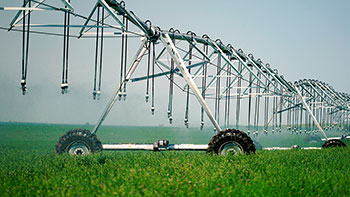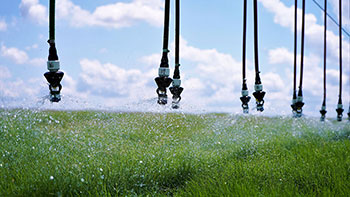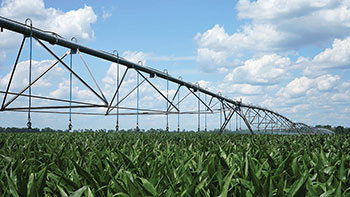
The center pivot sprinkler is a crucial component of center pivot irrigation systems to ensure uniform water distribution. In recent years, center pivot sprinklers have come a long way with designs that help growers save water and energy while improving crop yields. This article will explore different types of sprinklers available for center pivot irrigation. It will also examine essential considerations for selecting the right sprinkler package and highlight Senninger solutions that can enhance the efficiency of your mechanized irrigation setup.
Types of center pivot sprinklers and technologies
1. Impact Sprinklers
Impact sprinklers are one of the oldest and most common sprinklers used in center pivot irrigation. Impact sprinklers employ a rotating splash arm, which causes the sprinkler to produce a pulsating stream of water. Impact sprinklers are relatively inexpensive and simple to maintain, but they can be less efficient than other types of sprinklers. They deliver a more concentrated distribution pattern, and the small droplets produced when the splash engages the water stream are prone to wind drift.
2. Spray Sprinklers
Spray nozzles are a common choice for center pivot irrigation systems. These sprinklers produce different distribution patterns based on the design of the deflector pad. The streams of water released break up into droplets before they reach the ground, making them suitable for a wide range of crops and are relatively easy to maintain. When these sprinklers are used on hose drops, those droplets are less susceptible to wind drift than impact sprinklers and are less expensive to maintain.
3. Wobbler Technology™
Wobbler technology represents a significant advancement in center pivot sprinklers. Instead of a fixed spray pattern, wobbler sprinklers feature a unique off-center rotary action. This rotation combined with the wobbling action breaks up the stream into larger droplets which are less prone to wind drift and evaporation. It provides superior water distribution uniformity, making it an excellent choice for maximizing irrigation efficiency. Models are available for drop hose or top-of-pipe and operate at low pressures, providing water and energy-saving benefits.
4. Moving Plate Sprinklers
Sprinklers with moving deflectors are often selected because they deliver a wider footprint than sprays. The groove geometry and trajectory of the deflector determine the rotation speed and distribution pattern. This allows irrigators choices based on their crop and soil needs. Most are engineered to operate at lower pressure, providing energy-saving benefits. Others can be used at higher pressures without pressure regulators when the field has no elevation changes.
5. LEPA (Low Energy Precision Application) Bubble Sprinklers
LEPA bubble sprinklers are specifically designed for high-efficiency irrigation. These sprinklers are mounted on drop hoses close to the crop and distribute water in a gentle bubble pattern, reducing water losses to wind and evaporation. Because LEPA systems operate at low pressure, they save energy. LEPA systems achieve a more uniform root zone coverage and help increase yield using less water making them ideal for water-scarce regions and crops that require precise watering.
Understanding Soil Characteristics
Before diving into sprinkler selection, gathering information about the various soils within your field is essential. Relevant soil characteristics include texture, infiltration rate, water holding capacity, and slope. These factors determine how well the water will be absorbed and help ensure the root system receives what it needs to produce a healthy crop. Understanding your soil's needs is the foundation for making informed sprinkler choices to maximize yield.
Maximize Crop Irrigation Efficiency with the Right Center Pivot Sprinkler
Regarding center-pivot irrigation, your system's efficiency largely depends on selecting the proper sprinkler package. These sprinklers must deliver water in the way the soil and crop need to minimize runoff, reduce evaporation, and eliminate drift. In addition, you should space and position them appropriately to maximize uniform application and ensure the correct application rate. Below, we share key considerations when choosing a sprinkler package for your center pivot system.
Operating Pressure
 Operating the system at the designed pressure is vital for achieving uniform application from the selected sprinkler package. Ensure your irrigation system maintains the specified pressure levels to avoid performance issues. Because sprinklers are designed to operate at a certain pressure, employing pressure regulators helps ensure optimal sprinkler performance.
Operating the system at the designed pressure is vital for achieving uniform application from the selected sprinkler package. Ensure your irrigation system maintains the specified pressure levels to avoid performance issues. Because sprinklers are designed to operate at a certain pressure, employing pressure regulators helps ensure optimal sprinkler performance.
Addressing Losses in Application Efficiency
Efficient irrigation depends on minimizing various types of losses that can reduce application efficiency:
1. Overspray and Drift
Overspray and drift occur when the wind carries away water droplets or those water droplets fall outside the target area. Choosing the right sprinkler type can help reduce these losses. Sprinkler designs like the Wobbler or other low-pressure sprinklers are designed to minimize wind drift and overspray.
2. Droplet Evaporation
Evaporation of water droplets before they reach the ground can lead to inefficient water use. Sprinklers that produce mist due to higher pressure operation or component interaction, like the splash arm interacting with the water stream in impacts, are prone to evaporative losses. Sprinklers that produce larger droplets comprise most packages that are better at reducing evaporation.
3. Runoff
Runoff occurs when water is applied at a rate higher than the soil's infiltration capabilities, exceeding the surface storage capacity. Larger wetted diameters provided by specific sprinkler packages can extend application time, reducing the risk of runoff. It's essential to select sprinklers that match the soil intake characteristics of your field. A professionally designed sprinkler package helps ensure the proper model is selected and the specific flow from each outlet along the mainline Is used.
Wheel Tracks
The center pivot's movement creates wheel tracks at the towers. With overwatering or improper sprinkler installation, rutting can result, potentially causing operational challenges and potentially causing damage to the pivot. To mitigate this, consider using boom backs or part-circle sprinklers on rigid drops to keep wheel tracks dry.
Center Pivot Sprinkler Height and Spacing
 The height at which sprinklers are mounted affects the wetted diameter. Field elevation changes dictate the best height as the pivot travels around the field. Sprinkler spacing is often dictated by the brand of center pivot selected, as their outlets are placed at select spacing along the pivot span.
The height at which sprinklers are mounted affects the wetted diameter. Field elevation changes dictate the best height as the pivot travels around the field. Sprinkler spacing is often dictated by the brand of center pivot selected, as their outlets are placed at select spacing along the pivot span.
Based on plant spacing and crop height at critical water need periods, sprinklers operating beneath the crop canopy may not deliver the same uniform distribution pattern as those above the crop. These systems should employ closer spacing as they rely on water infiltration to reach the root zone for the crop needs. This can be accomplished by employing goosenecks and truss rod hose slings that allow additional sprinklers to be added.
Some growers select top-of-pipe sprinklers instead, as this installation allows them to apply chemicals above the crop canopy through their package.
Here are some recommendations regarding sprinklers:
1. Secure a professionally designed sprinkler package to ensure optimum system performance.
2. Follow the sprinkler manufacturer’s installation recommendations as they conduct extensive testing to determine the best configurations for various conditions.
3. Ensure the nozzle size at each outlet matches the printout received from the sprinkler package.
4. Monitor sprinkler performance throughout the season. This can be done utilizing AI technologies or as simple as watching for differences in distribution patterns in adjacent sprinklers. This will signal issues that need to be addressed.
5. Watch for inconsistent crop development across the field, as this signals issues that need to be addressed. This is especially important with older sprinkler packages.
Conclusion
1. Familiarize yourself with different types of sprinklers. Ask your irrigation dealer for recommendations and secure a professionally designed sprinkler package.
2. Know the characteristics of the soil and any elevation changes across your field.
3. Know the operating pressure of your system and ensure you have the necessary pressure to operate the sprinkler package.
4. Ensure that the sprinklers are installed according to the manufacturer’s recommendations and that each sprinkler is nozzled correctly based on the sprinkler chart from your dealer.
5. Keep an eye on your system throughout the growing season to help mitigate any issues before they become a problem that would impact your overall yield.
By following these guidelines and tailoring your sprinkler package to your specific field conditions, you can enhance the efficiency and effectiveness of your center pivot irrigation system while conserving water resources.

